 Ṣaḍbala Introduction - Ṣaḍbala Defined Derived from ṣaḍ (six) and bala (strength), ṣaḍbala refers to the six sources of visible or true strength of a planet. These are different from the other sources of strength of the planet which are changeable and therefore considered untrue. Maharṣi Parāśara uses the word spaṣṭa bala for...
Ṣaḍbala Introduction - Ṣaḍbala Defined Derived from ṣaḍ (six) and bala (strength), ṣaḍbala refers to the six sources of visible or true strength of a planet. These are different from the other sources of strength of the planet which are changeable and therefore considered untrue. Maharṣi Parāśara uses the word spaṣṭa bala for...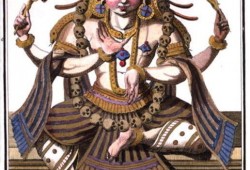 Sthāna Bala - The word sthāna generally means place and position and sthāna bala includes various details about the native. Position Position or posture of the body; the kendra have four postures of standing, sleeping, sitting and walking; yet this can be more detailed Dignity Rank and office which is by appointment or...
Sthāna Bala - The word sthāna generally means place and position and sthāna bala includes various details about the native. Position Position or posture of the body; the kendra have four postures of standing, sleeping, sitting and walking; yet this can be more detailed Dignity Rank and office which is by appointment or... Uccha Bala - अथ स्पष्टबलं वक्ष्ये स्थानकालादिसम्भवम्। नीचोनां खचरं भार्धाधिक चक्राद् विशोधयेत्॥ १॥ atha spaṣṭabalaṁ vakṣye sthānakālādisambhavam | nīconāṁ khacaraṁ bhārdhādhika cakrād viśodhayet || 1 भागीकृत्य त्रिभिर्भक्तं लब्धमुच्चबलं भवेत्। bhāgīkṛtya tribhirbhaktaṁ labdhamuccabalaṁ bhavet | 2½ The calculation is extremely simple. Consider two factors (a) Longitude of Planet, say ‘P’ and (b) Debilitation Degree...
Uccha Bala - अथ स्पष्टबलं वक्ष्ये स्थानकालादिसम्भवम्। नीचोनां खचरं भार्धाधिक चक्राद् विशोधयेत्॥ १॥ atha spaṣṭabalaṁ vakṣye sthānakālādisambhavam | nīconāṁ khacaraṁ bhārdhādhika cakrād viśodhayet || 1 भागीकृत्य त्रिभिर्भक्तं लब्धमुच्चबलं भवेत्। bhāgīkṛtya tribhirbhaktaṁ labdhamuccabalaṁ bhavet | 2½ The calculation is extremely simple. Consider two factors (a) Longitude of Planet, say ‘P’ and (b) Debilitation Degree...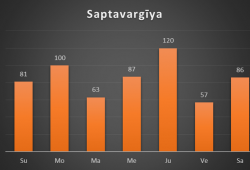 Saptavargīya Bala - स्वत्रिकोणस्वगेहाधिमित्रमित्रसमारिषु॥ २॥ svatrikoṇasvagehādhimitramitrasamāriṣu || 2½ अधिशत्रुगृहे चापि स्थितानां क्रमशो बलम्। भूताब्धयः खाग्निनखास्तिथ्यो दश युगाः कराः॥ ३॥ adhiśatrugṛhe cāpi sthitānāṁ kramaśo balam | bhūtābdhayaḥ khāgninakhāstithyo daśa yugāḥ karāḥ || 3||एवं होरादृकाणाद्रिभागांकद्वादशांशजम्। त्रिंशांशजं तदैक्यञ्च सप्तवर्गसमुद्भवम्॥ ४॥ evaṁ horādṛkāṇādribhāgāṁkadvādaśāṁśajam | triṁśāṁśajaṁ tadaikyañca saptavargasamudbhavam || 4| Sapta means seven and varga refers to the...
Saptavargīya Bala - स्वत्रिकोणस्वगेहाधिमित्रमित्रसमारिषु॥ २॥ svatrikoṇasvagehādhimitramitrasamāriṣu || 2½ अधिशत्रुगृहे चापि स्थितानां क्रमशो बलम्। भूताब्धयः खाग्निनखास्तिथ्यो दश युगाः कराः॥ ३॥ adhiśatrugṛhe cāpi sthitānāṁ kramaśo balam | bhūtābdhayaḥ khāgninakhāstithyo daśa yugāḥ karāḥ || 3||एवं होरादृकाणाद्रिभागांकद्वादशांशजम्। त्रिंशांशजं तदैक्यञ्च सप्तवर्गसमुद्भवम्॥ ४॥ evaṁ horādṛkāṇādribhāgāṁkadvādaśāṁśajam | triṁśāṁśajaṁ tadaikyañca saptavargasamudbhavam || 4| Sapta means seven and varga refers to the...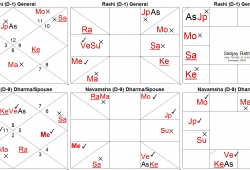 Oja-yugma-rāśi-aṁśa bala - शुक्रेन्दू समभांशेऽन्ये विषमेऽञ्घ्रिमितं बलम्। śukrendū samabhāṁśe’nye viṣame’ñghrimitaṁ balam |5 ½ Translation: Venus and Moon in even signs and the other [planets] in odd signs get one-foot strength. The word अञ्घ्रि (añghri) means a foot. In jyotiṣa, all measures are always expressed as having four feet, like nakṣatra have four pada....
Oja-yugma-rāśi-aṁśa bala - शुक्रेन्दू समभांशेऽन्ये विषमेऽञ्घ्रिमितं बलम्। śukrendū samabhāṁśe’nye viṣame’ñghrimitaṁ balam |5 ½ Translation: Venus and Moon in even signs and the other [planets] in odd signs get one-foot strength. The word अञ्घ्रि (añghri) means a foot. In jyotiṣa, all measures are always expressed as having four feet, like nakṣatra have four pada....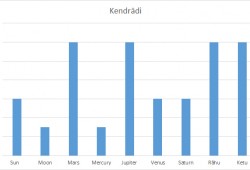 Kendrādi Bala - केन्द्रादिषुस्थिताः खेटाः पूर्णाऽर्धाऽङ्घ्रिमितं क्रमात्॥ ५॥ kendrādiṣusthitāḥ kheṭāḥ pūrṇā’rdhā’ṅghrimitaṁ kramāt || 5|| Translation: Planets in Kendra, Paṇapara and Apoklimas obtain full, half and quarter strength respectively. Previously in PJC-Year2 we had learnt the importance of the Kendra, which is the grand cross where the lotus of life blooms guarded by the...
Kendrādi Bala - केन्द्रादिषुस्थिताः खेटाः पूर्णाऽर्धाऽङ्घ्रिमितं क्रमात्॥ ५॥ kendrādiṣusthitāḥ kheṭāḥ pūrṇā’rdhā’ṅghrimitaṁ kramāt || 5|| Translation: Planets in Kendra, Paṇapara and Apoklimas obtain full, half and quarter strength respectively. Previously in PJC-Year2 we had learnt the importance of the Kendra, which is the grand cross where the lotus of life blooms guarded by the...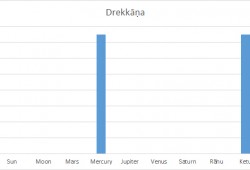 Drekkāṇa Bala - आद्यमध्यावसानेषु द्रेष्काणेषु स्थिताः क्रमात्। पुंनपुंसकयोषाख्या दद्युरङ्घ्रिमितं बलम्॥ ६॥ ādyamadhyāvasāneṣu dreṣkāṇeṣu sthitāḥ kramāt | puṁnapuṁsakayoṣākhyā dadyuraṅghrimitaṁ balam || 6 Translation: Drekkāṇa bala is based on the placement of planets in the initial (ādya), middle (madhya) or last (avasāna). पुं (puṁ) Male planets [Sun, Mars, Jupiter, Rāhu] in the initial (0°-10°) drekkāṇa...
Drekkāṇa Bala - आद्यमध्यावसानेषु द्रेष्काणेषु स्थिताः क्रमात्। पुंनपुंसकयोषाख्या दद्युरङ्घ्रिमितं बलम्॥ ६॥ ādyamadhyāvasāneṣu dreṣkāṇeṣu sthitāḥ kramāt | puṁnapuṁsakayoṣākhyā dadyuraṅghrimitaṁ balam || 6 Translation: Drekkāṇa bala is based on the placement of planets in the initial (ādya), middle (madhya) or last (avasāna). पुं (puṁ) Male planets [Sun, Mars, Jupiter, Rāhu] in the initial (0°-10°) drekkāṇa...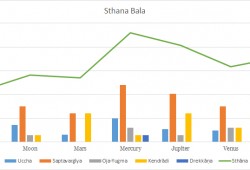 Sthāna Bala Overview - The sum of the five parts viz. uccha bala, saptavargīya bala, oja-yugma-rāśi-aṁśa bala, kendrādi bala and drekkāṇa bala gives the sthāna bala. In this example we have computed the sthāna bala for the seven weekday planets which is normally done by vedic astrologers. Planet Sthāna Bala Uccha Saptavargīya Oja-Yugma Kendra...
Sthāna Bala Overview - The sum of the five parts viz. uccha bala, saptavargīya bala, oja-yugma-rāśi-aṁśa bala, kendrādi bala and drekkāṇa bala gives the sthāna bala. In this example we have computed the sthāna bala for the seven weekday planets which is normally done by vedic astrologers. Planet Sthāna Bala Uccha Saptavargīya Oja-Yugma Kendra...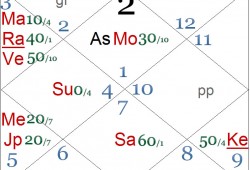 Digbala - Digbala is composed of दिग् (dig) and बल (bala) simply meaning directional strength. However the word दिग् (dig) is a compounded form of दिश् (diś) which has various meanings and connotations. To understand digbala we need to know the meanings of दिश् (diś) – Quarter or region pointed at, a...
Digbala - Digbala is composed of दिग् (dig) and बल (bala) simply meaning directional strength. However the word दिग् (dig) is a compounded form of दिश् (diś) which has various meanings and connotations. To understand digbala we need to know the meanings of दिश् (diś) – Quarter or region pointed at, a... Kāla Bala - There are umpteen meanings of the word काल (kāla), a proper understanding of which is very necessary for all vedic astrologers. In the context of kāla bala, we use the meaning as ‘a measure of time’. When we think of the passage of time, it manifests as changing seasons, and...
Kāla Bala - There are umpteen meanings of the word काल (kāla), a proper understanding of which is very necessary for all vedic astrologers. In the context of kāla bala, we use the meaning as ‘a measure of time’. When we think of the passage of time, it manifests as changing seasons, and...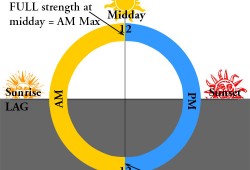 Natonnata Bala - The compound word natonnata (नतोन्नत) is composed of two words (a) नत nata and its anonym (b) उन्नत unnata. Some translations and books have mistakenly spelt this word ‘nata’ as ‘natha’. Be sure that there is no such Sanskrit word as नथ (natha) and the one with the longer ‘ā’...
Natonnata Bala - The compound word natonnata (नतोन्नत) is composed of two words (a) नत nata and its anonym (b) उन्नत unnata. Some translations and books have mistakenly spelt this word ‘nata’ as ‘natha’. Be sure that there is no such Sanskrit word as नथ (natha) and the one with the longer ‘ā’...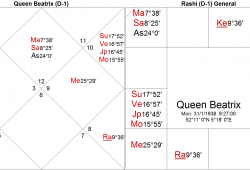 Pakṣa Bala - Pakṣa refers to the waxing and waning phases of the Moon which is divided into the śukla pakṣa (waxing phase) and kṛṣṇa pakṣa (waning phase). The maximum angular displacement of the Moon from the Sun is 180° which is the moment of pūrṇānta (end of pūrṇimā, full moon). Just as...
Pakṣa Bala - Pakṣa refers to the waxing and waning phases of the Moon which is divided into the śukla pakṣa (waxing phase) and kṛṣṇa pakṣa (waning phase). The maximum angular displacement of the Moon from the Sun is 180° which is the moment of pūrṇānta (end of pūrṇimā, full moon). Just as... Tribhāga Bala - दिनत्र्यंशेषु सौम्यार्कशनीनां निट्त्रिभागके। चन्द्रशुक्रकुजानां च बलं पूर्णं सदा गुरोः॥ १२॥ dinatryaṁśeṣu saumyārkaśanīnāṁ niṭtribhāgake | candraśukrakujānāṁ ca balaṁ pūrṇaṁ sadā guroḥ || 12| Translation: The three-parts of the day-time are lorded by Mercury, Sun and Saturn in that order while the three-parts of the night have Moon, Venus and Mars as...
Tribhāga Bala - दिनत्र्यंशेषु सौम्यार्कशनीनां निट्त्रिभागके। चन्द्रशुक्रकुजानां च बलं पूर्णं सदा गुरोः॥ १२॥ dinatryaṁśeṣu saumyārkaśanīnāṁ niṭtribhāgake | candraśukrakujānāṁ ca balaṁ pūrṇaṁ sadā guroḥ || 12| Translation: The three-parts of the day-time are lorded by Mercury, Sun and Saturn in that order while the three-parts of the night have Moon, Venus and Mars as... Varṣeśādi Bala - वर्षमासदिनेशानां तिथ्यस्त्रिंशच्छरार्णवां। होरेशस्य बलं षष्टिरुक्तं नैसर्गिकं पुरा॥ १३॥ varṣamāsadineśānāṁ tithyastriṁśaccharārṇavāṁ | horeśasya balaṁ ṣaṣṭiruktaṁ naisargikaṁ purā || 13|| Translation: Parāśara says that the lords of the varṣa (year), māsa (month), dina (weekday) and horā (hour) have Varṣeśādi bala increasing by 15 virūpa. Explanation The four planets that attain the position...
Varṣeśādi Bala - वर्षमासदिनेशानां तिथ्यस्त्रिंशच्छरार्णवां। होरेशस्य बलं षष्टिरुक्तं नैसर्गिकं पुरा॥ १३॥ varṣamāsadineśānāṁ tithyastriṁśaccharārṇavāṁ | horeśasya balaṁ ṣaṣṭiruktaṁ naisargikaṁ purā || 13|| Translation: Parāśara says that the lords of the varṣa (year), māsa (month), dina (weekday) and horā (hour) have Varṣeśādi bala increasing by 15 virūpa. Explanation The four planets that attain the position...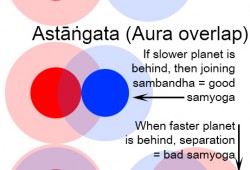 Yuddha Bala - Meaning of Yuddha The word युद्ध (yuddha) as is generally understood, means to fight, battle, encounter, conquer and subdue. It implies the power to oppose and is symbolised in the sky by a conflict of the planets. The word योध (yodha) refers to a fighter, warrior, soldier or even a...
Yuddha Bala - Meaning of Yuddha The word युद्ध (yuddha) as is generally understood, means to fight, battle, encounter, conquer and subdue. It implies the power to oppose and is symbolised in the sky by a conflict of the planets. The word योध (yodha) refers to a fighter, warrior, soldier or even a...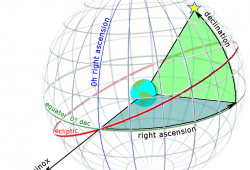 Ayana Bala - Introduction
Ayana Bala - Introduction
Parāśara Jyotiṣa Course

ओमच्युताय गुरवे शिष्यसंसारसेतवे।
भक्तकार्यैकसिंहाय नमस्ते चित्सुखात्मने॥
omacyutāya gurave śiṣyasaṁsārasetave | bhaktakāryaikasiṁhāya namaste citsukhātmane ||
omacyutāya gurave śiṣyasaṁsārasetave | bhaktakāryaikasiṁhāya namaste citsukhātmane ||
Login
PJC Year-3
Rūpa: Strength Measure
When we start learning about ṣaḍbala, we constantly come across a word rūpa which is used in the sense of...
Ṣaḍbala Introduction
Introduction Before we venture into describing the six sources of strengths, we need to know why there are six strengths,...
Mohanraja | Upadhyaya
Asanapuram Mohanraja Subrahmanyam, also known as AM Raja, was born and raised in a spiritually inclined family in Tirupati, a...
Page 1 of 1
About Program
[caption id="attachment_52" align="alignright" width="216"] ॐ नमः शिवाय गुरुविश्वेश्वराय नमःom namaḥ śivāya guruviśveśvarāya namaḥ[/caption] Syllabus Chapters of Bṛhat Parāśara Horā Śāstra...
Syllabus
The syllabus for each academic year of the PJC is based on Topics which include some chapters of the monumental...
Rūpa: Strength Measure
When we start learning about ṣaḍbala, we constantly come across a word rūpa which is used in the sense of...
Page 1 of 2
Viparīta Argala
Jyotiṣa Terminology विपरीत viparīta Turned round, reversed, inverted and being the reverse of anything. It shows something that is acting...
Himalaya 2014 Part-B
The Himalaya Classes for PJC-2B were held in the fall of 2014 and in-spite of the cold, we did manage...
Digbala
Digbala is composed of दिग् (dig) and बल (bala) simply meaning directional strength. However the word दिग् (dig) is a...
Page 1 of 19
Learn from Tradition
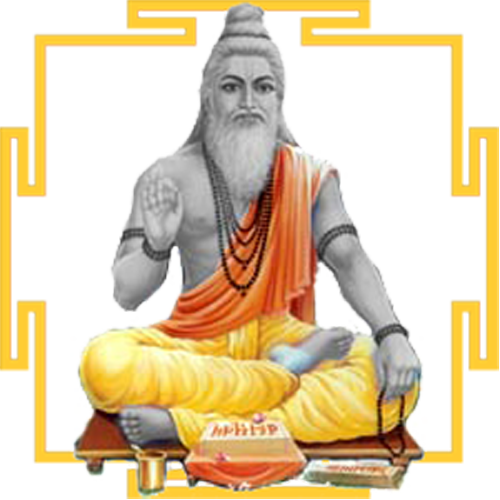 Sohamsa offers online courses in jyotish (Vedic Astrology) taught directly by Sanjay Rath as per the tradition, through narrated power points and other audio tools. The courses are at different levels, from the beginners through the intermediate to the advanced and are known as SoHamsa | DBC courses, with individual classrooms and assistant teachers
Sohamsa offers online courses in jyotish (Vedic Astrology) taught directly by Sanjay Rath as per the tradition, through narrated power points and other audio tools. The courses are at different levels, from the beginners through the intermediate to the advanced and are known as SoHamsa | DBC courses, with individual classrooms and assistant teachersCertificate Course, Jaimini Scholars
Free Courses
Contact Info
Devaguru Bṛhaspati Center is committed to the highest standards of vedic astrology, and we can say with confidence that we have the finest, most rigorous courses and most erudite scholars to teach the same.
15B Ganga Ram Hospital Road, New Delhi 110060
+91-11-45641849
15B Ganga Ram Hospital Road, New Delhi 110060
+91-11-45641849
DBC Programs
Only Certified Jaimini Scholars
Five Year Jyotiṣa Grandmaster
Real Traditional Vedic Astrology
Mantra Foundation, Śiva Mahāpurāṇa ..more
Five Year Jyotiṣa Grandmaster
Real Traditional Vedic Astrology
Mantra Foundation, Śiva Mahāpurāṇa ..more
Copyright © 2026 PJC-3 Jagannath
